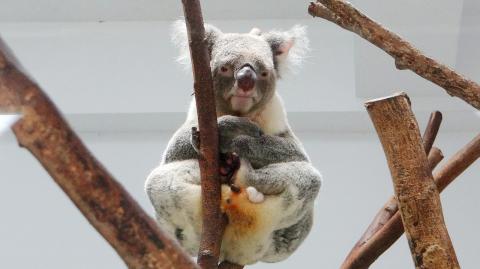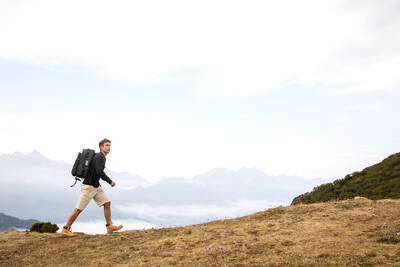Why are koalas always sleeping? Don’t koalas have tails? Are koalas bears? To answer questions about koalas from members of the public, Taipei Zoo organizes educational talks at its Koala House every Thursday and Saturday at 11am. Koala keepers have even made illustrated books to help visitors gain quick and in-depth knowledge about the animal.
The staple diet of koalas is Eucalyptus leaves, which are rich in fiber but low in calories. In order to conserve energy, koalas spend most of their time resting and can sleep 18 to 20 hours a day. For anyone who wants to see a koala “in action,” a good time to visit the koalas would be at 2 o’clock in the afternoon, when keepers bring a new supply of Eucalyptus leaves into the enclosure.
The name “koala” originated from a term in an Australian aboriginal dialect, meaning “no drink.” Eucalyptus leaves contain a high amount of moisture, so koalas seldom need to drink water. Nonetheless, the zoo keepers still prepare a bowl of water for the koalas in case they need it.

Photo courtesy of Taipei Zoo
照片:台北市立動物園提供
Furthermore, the koala’s Chinese name, “wuweixiong,” which literally means “tailless bear,” has often caused people to mistake the animal for a bear without a tail. In fact, koalas do have tails. What’s more, they are marsupials, not bears. When they are old enough to leave their mother’s pouch, koala cubs have relatively noticeable tails, while adult koalas have long hair which often conceals their tails.
(LIBERTY TIMES, TRANSLATED BY TU YU-AN)
為什麼無尾熊總是在睡覺?無尾熊沒有尾巴嗎?無尾熊是熊嗎?為了解答民眾對於無尾熊的疑問,台北市立動物園每週四和週六上午十一點在無尾熊館推出講解課程,保育員還自製無尾熊繪本,引導遊客深入且快速地認識無尾熊。

Photo courtesy of Taipei Zoo
照片:台北市立動物園提供
無尾熊的主食尤加利葉屬於高纖、低熱量的食物,為了節省能量消耗,無尾熊大部分時間處於休息狀態,一天要睡上十八至二十小時。如果要看無尾熊「動起來」,可選在下午兩點保育員添置尤加利葉時前往。
無尾熊的名稱「Koala」源自於澳洲原住民方言,意指「不喝水」。因尤加利葉水分含量高,無尾熊通常不須喝水,但保育員還是會為無尾熊準備一盆水備用。
另外,中文「無尾熊」一詞也常讓民眾誤以為無尾熊是沒有尾巴的熊,實際上,無尾熊有尾巴,而且是有袋類,不是熊。剛離開育兒袋的小無尾熊寶寶尾巴較明顯,成年的無尾熊尾巴則多半是被長長的毛蓋住而不明顯。
(自由時報記者梁珮綺)

Have you ever dreamed of hiking Taiwan’s majestic Mt. Jade or visiting Peru’s breathtaking Machu Picchu? These adventures sound amazing, but there’s something you should know about first: “altitude sickness.” This condition strikes when you climb to a higher elevation too quickly. The higher you go, the thinner the air becomes, making it harder for your body to absorb oxygen. The symptoms usually begin within hours of reaching high altitudes — about 2,500 meters or higher. You might experience headaches, dizziness, nausea, shortness of breath, or extreme fatigue. These symptoms can last for several days. The severity of altitude sickness varies

★ Bilingual Story is a fictionalized account. 雙語故事部分內容純屬虛構。 “Get in. It’s pouring.” She slid into the back seat, drenched and silent. “Tissues?” the driver asked. “No, thank you,” she said. Water beaded off her hair, ran from her coat, and made a small lake on the vinyl. She kept her head down, long black strands clinging to her face. “Where to?” She gave an address. “Funeral?” he asked as they slipped into the Xinhai Tunnel, rain fading to a hollow drum. She glanced up, puzzled. “No. Why?” “Crematorium’s about the only thing here.” He caught her eyes in the mirror.

A: In addition to boyband Energy’s concerts, Taiwan’s first major male dance revue has attracted attention. B: Several South Korean male dance revues and Australia’s Thunder from Down Under often tour Taiwan. Now Taiwan’s first all-male revue has finally appeared. A: According to the Liberty Times, Muscle High: A Male Dance Revue from Taiwan, featuring 13 hunks, opened last month and will run until Sept. 14. B: The rise of “hunk fever” in recent years has even caused a trend of working out in Asia. A: Let’s go to the Taipei Music Center’s Sub Livehouse for the show. A:

A: Any fun events happening this weekend? B: Boyband Energy’s concerts and Taiwan’s first major male dance revue have both sparked anticipation recently. A: Energy staged a comeback last year — 15 years after they disbanded — and they’re now more popular than ever. B: Their megahit “Friday Night” even won Song of the Year at the Golden Melody Awards. A: To pay tribute to the Queen of Pop Madonna, they added her choreography of 16 continuous jump squats to their music video, prompting a “16-squat challenge” that went viral across Taiwan. Do you wanna try it out? A: